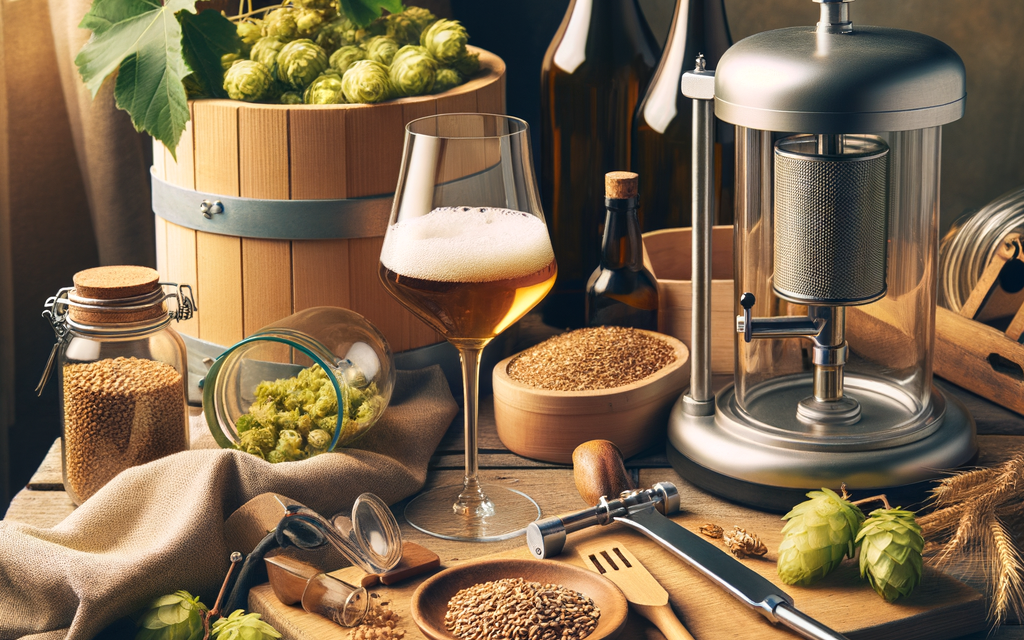Introduction
Embracing the art of home brewing and winemaking can be a delightful and empowering pursuit, offering not only a creative outlet but also the opportunity to enjoy the fruits of your labor with friends and family. This craft allows you to tailor flavors to your preference, understand the nuances of beverage making, and perhaps even contribute to a healthier lifestyle by controlling the ingredients that go into your drinks. With the right guidance, you can transform your kitchen into a personal brewery or winery.
Getting Started with Home Brewing
Essential Equipment
- Brewing kettle
- Fermenter and airlock
- Sanitizer
- Stirring spoon
- Beer recipe kit (or ingredients like malt extract, hops, yeast)
- Bottles, caps, and a capper
For those new to brewing, the DIAH DO IT AT HOME Beer & Wine Making Starter Kit offers a basic set of equipment to help you get started with your first batch of homemade beer or wine.
Steps for Brewing Beer
- Sanitize Everything: Any equipment that comes into contact with your beer must be sanitized to prevent contamination.
- Boil Your Brew: Follow your beer recipe kit or recipe to boil your malt extracts, adding hops as directed.
- Fermentation: Cool the mixture and transfer it to your fermenter, adding water to reach the required volume. Then, add the yeast to start fermentation.
- Bottling: After fermentation (usually a few weeks), transfer your beer into sanitized bottles, add priming sugar to carbonate, cap them, and let them sit for another couple of weeks.
For a simple and convenient brewing experience, consider the DIAH DO IT AT HOME Simply Pale Ale Beer Kit and Airlock Set, which includes the essentials for brewing a classic Pale Ale.
Tips and Mistakes to Avoid
- Don’t skimp on sanitation – it’s the most crucial step to avoid spoilage.
- Be patient with fermentation – rushing this process can result in incomplete fermentation or off-flavors.
- Control your fermentation temperature to ensure the best flavor profile.
Embarking on Winemaking
Essential Equipment
- Primary fermenter and secondary fermenter
- Airlock and bung
- Sanitizer
- Hydrometer
- Wine recipe kit (or ingredients like juice, yeast, nutrients)
- Wine bottles and corks
If you’re interested in starting winemaking, the BJ #3 PET Kit – Winemaking Set is an ideal choice for beginners looking to make up to 6 bottles, while the BJ #5s Kit – 25L Premium Winemaking Equipment Set is perfect for those looking to produce larger batches of up to 30 bottles.
Steps for Making Wine
- Sanitize Your Equipment: As with brewing, cleanliness is essential.
- Prepare the Must: Combine the juice (or crushed grapes) with yeast and other ingredients in your primary fermenter.
- Primary Fermentation: Allow the must to ferment for about a week, then transfer it to the secondary fermenter.
- Secondary Fermentation and Aging: Let the wine age in the secondary fermenter, racking it off the sediments periodically.
- Bottling: Once the wine is clear and has reached its desired taste, bottle and cork it. Wine often benefits from additional aging in the bottle.
The Browin 400000 Winemaking Starter Kit is a comprehensive option that includes a 15l Demijohn, suitable for both beginners and professionals looking to craft their own wine, cider, or mead.
Tips and Mistakes to Avoid
- Use quality ingredients – the quality of your wine is directly related to the quality of the juice or grapes you start with.
- Monitor the fermentation process closely with a hydrometer to ensure it’s progressing correctly.
- Avoid exposing the wine to too much oxygen during transfers to prevent oxidation.
Conclusion
Whether it’s the warmth of summer that inspires a crisp home-brewed ale, or the chill of winter that calls for a rich, homemade red wine, any season is the perfect time to embark on the journey of home brewing and winemaking. Remember, the key to success in these endeavors is patience, cleanliness, and a willingness to learn from each batch. Each bottle you cap or cork is a testament to your dedication to this timeless craft. So, gather your equipment, choose your ingredients, and start your adventure in home brewing and winemaking today!
For additional resources and guidance, consider visiting organizations such as the American Homebrewers Association or the UK Wine Forum for tips, recipes, and community support.










